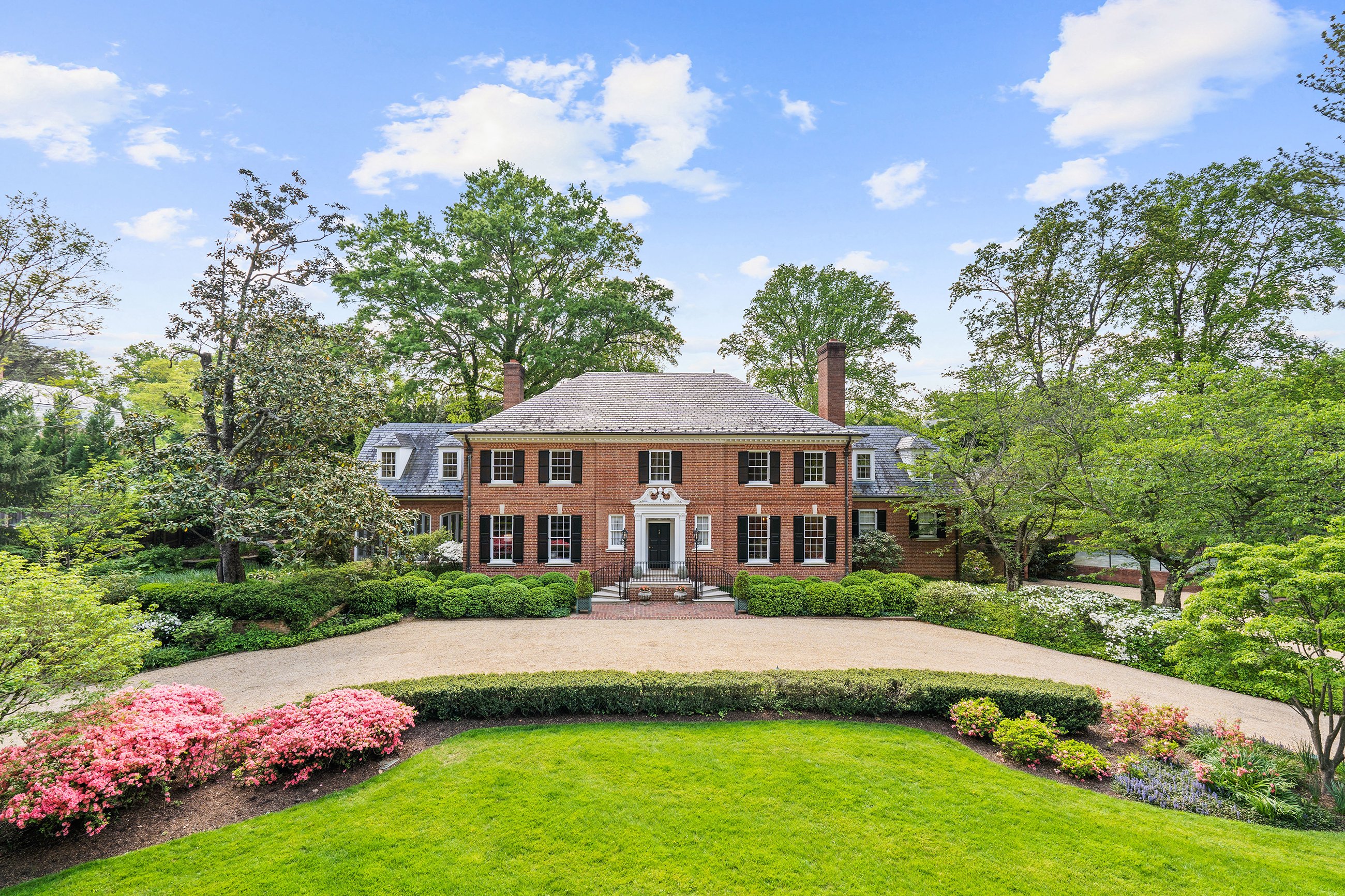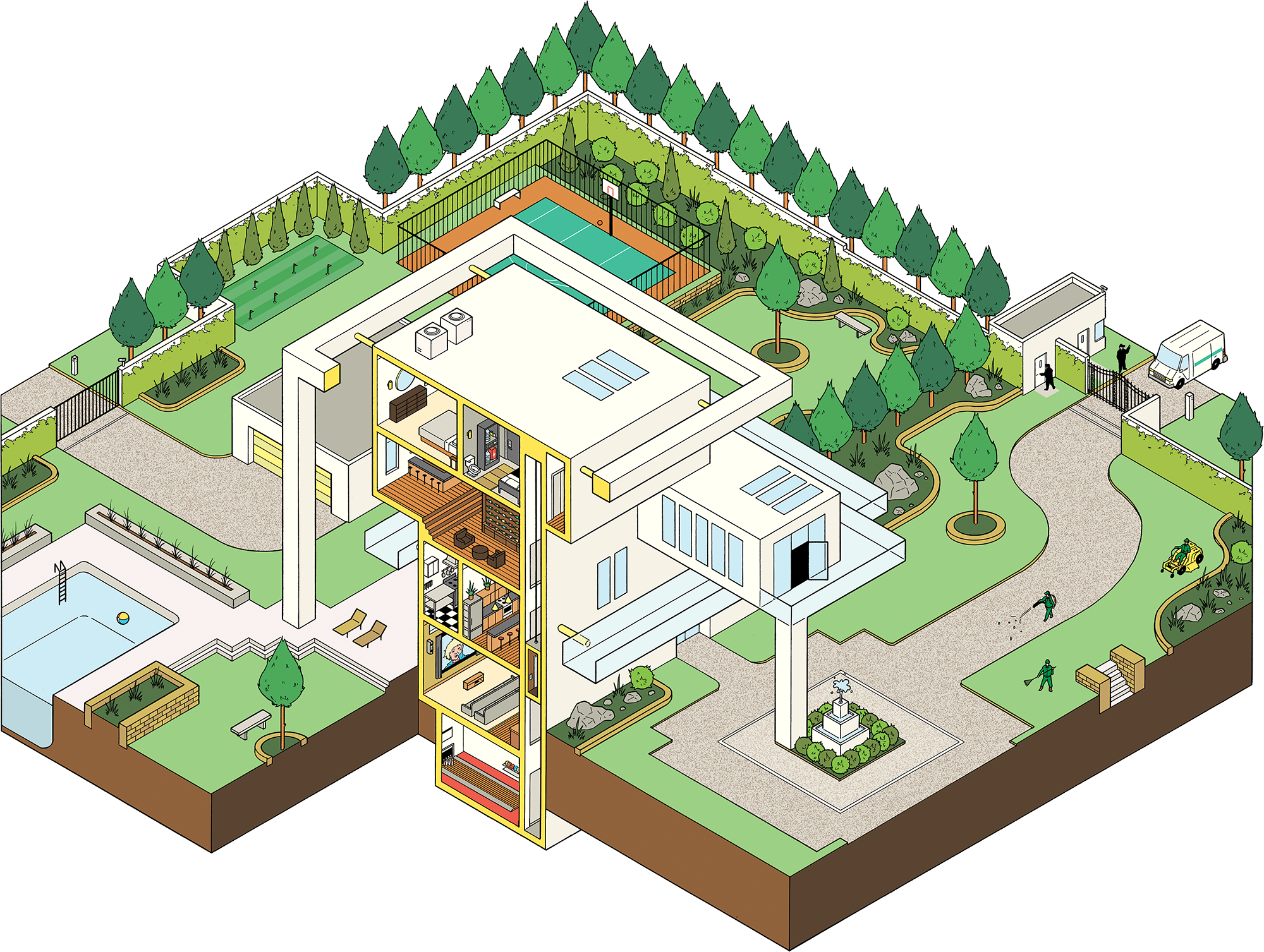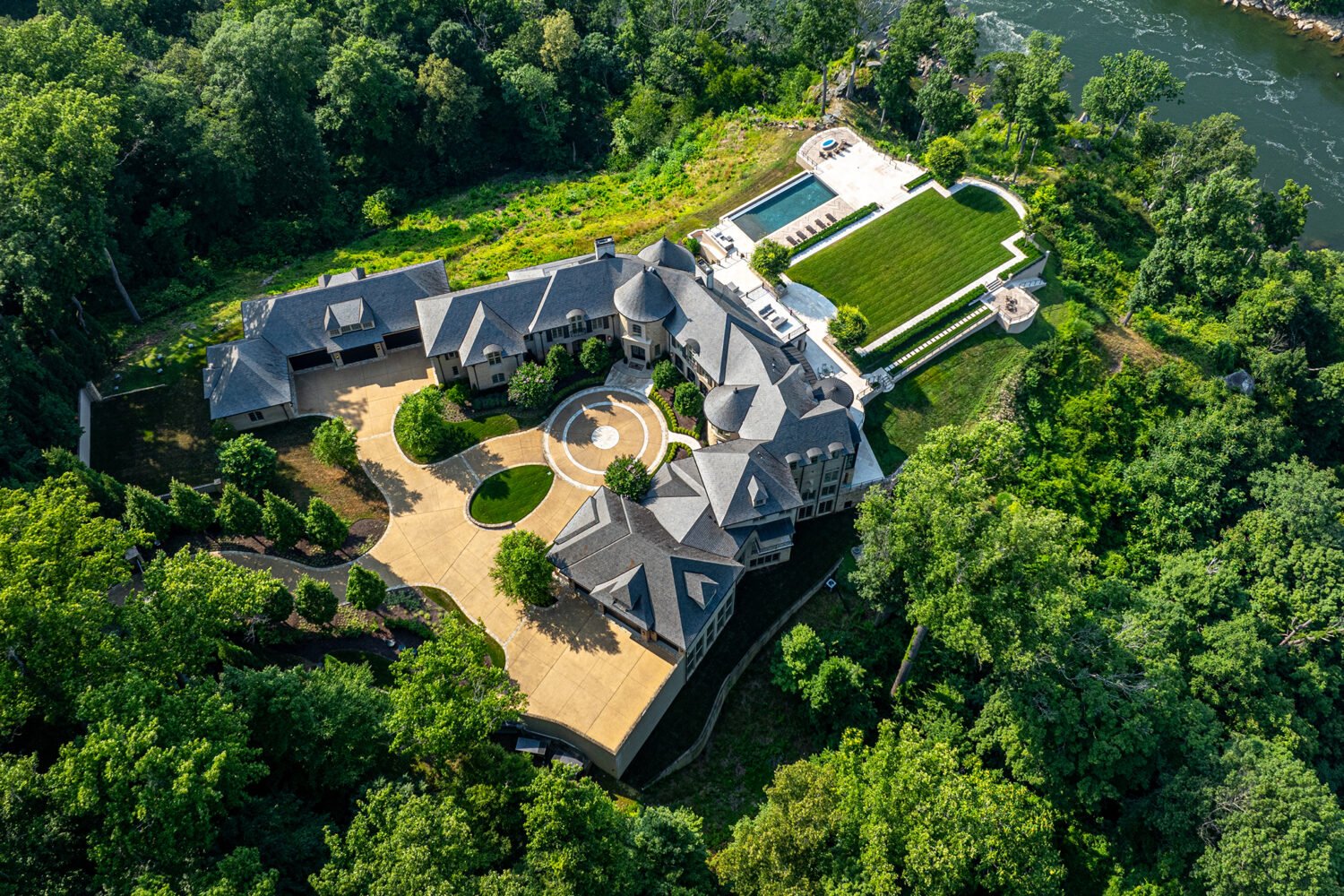Inside the Secret World of Luxury Real Estate in DC
NDAs, private listings, LLCs, security teams. Power brokers and high rollers in DC have countless ways of shielding their properties from prying eyes—or threats far worse. Here’s how the elites create a layer of privacy around their homes.
A pocket listing, as such a listing is often also called, might go up for sale without any public notice, and it might go under contract and sell just as quietly, the buyer’s identity shielded by an LLC or trust. A seller might not command the highest possible sales price with a private listing, but a more important consideration might be discretion—no open houses, no nosy neighbors, no public glimpse of the inner workings of their Washington life.
DC has always been a city where discretion and privacy are a cherished—and necessary—commodity. Pocket listings have a long history here. But the need for privacy has only seemed to grow more pressing. We live in an age of drones and smartphones, of TMZ and influencers looking to score a scoop. Maybe you want to shield the intimate details of your life, and that of your family, from prying eyes. Maybe you’re a professional athlete worried about a burglar targeting your house on game day or a politician worried about death threats. With the arrival of all the attendant billionaires and tech gurus during the second Trump administration, the luxury real-estate market has witnessed a surge in activity—the so-called Trump bump—which has helped spotlight the existence of this shadow submarket, where untold millions in deals might be shrouded in relative secrecy.
How can you create a zone of privacy around where you live? The question might apply equally to a victim of domestic violence; a journalist who worries about being doxxed; a CIA agent or therapist; a judge targeted during a RICO case; or someone who, for whatever reason, prioritizes anonymity. And it might apply not just to the sale of a property but to the renovation or construction of a new house, or to the design of a safe room (a.k.a. a panic room) or other security plan.
The vast majority of us will remain blissfully ignorant of these concerns. We’ll never ask an agent or architect to sign a nondisclosure agreement (see below for more on the rise of the real estate NDA). And we’ll list our properties in the MLS, as Hryniewicki almost always suggests, even to his luxury sellers. But in select instances, for a select individual, only a pocket listing will do.
Deep Private

There are pocket listings and then there are highly secretive ones. “We call it deep private,” says Hryniewicki, referring to a private listing with no public information at all: no photos, no address, no sign outside. The only people who know about the listing are the seller, the agency, and anyone the agency contacts.
Jim Bell, an executive vice president of TTR Sotheby’s International Realty, describes it this way: “Almost a complete communications and media blackout. The people you’re communicating with are on a need-to-know basis. And no social media.” The appeal of these listings can be their exclusivity, says Bell: “Privacy and discretion create value, because they’re limited—very limited—commodities.”
With a deep pocket listing, making a sale relies on the networking of agents who traffic in these exclusive circles. “We’re constantly texting with each other trying to match these private clients with the private listings,” says Bell. “It’s not just the person and the property—to make it all come together, you have to have the person get into the property.”
In this ultra-luxe bracket, the logistics require a certain finesse. How do you get someone who might be busy running a hedge fund or multinational company in another state into the house during their one available window that month? An ill-timed snowstorm can blow up a deal. Or a buyer might suddenly emerge the night before. “We might get notice at 9:30 pm that the buyer is available at 8 am to show,” says Hryniewicki. “They want to see the house at 8 am because nobody’s on the streets. It’s sometimes awkward timing, but that’s on purpose: to create a level of privacy.”
In some cases, an agent showing a property might request that the wi-fi be turned off to prevent a Nest doorbell or security camera from recording the potential buyers. That level of discretion can extend to financial disclosures. “Sometimes we get letters from bankers saying, ‘Hey, we’re not going to disclose who this individual is, but this LLC has access to so many million in liquid assets,’ ” one agent told us. Typically, the two parties in a transaction know who’s on the other side of the table, but there are exceptions. In 2023, Jeff Bezos purchased a house in Indian Creek Island—Florida’s so-called Billionaire’s Bunker—for $79 million, after the seller, businessman Leo Kryss, agreed to chop $6 million off the asking price. Kryss sued—the case was ongoing at press time—claiming he never would have agreed to the reduction had he known that the buyer was Bezos. And that the brokerage, which represented both him and the Amazon founder, had misled him about the buyer’s identity.
Last August, Bright MLS clarified the rules around pocket listings. Before, private was assumed to mean private. If an agent advertised a property publicly, they posted it online in the MLS. Now they can list privately (keeping the address under wraps, say) but also pursue a marketing campaign—for example, placing a story in the Wall Street Journal that targets a jet-setting buyer pool. Following the update, many agents have launched a section on their websites featuring pocket listings, including TTR Sotheby’s Daniel Heider, whose Heider Private offers up varying levels of detail for available properties—maybe an address and list price, or maybe just a general location and description. “I read the top sales of the year by various outlets,” says Heider, only to discover they’re missing some of the biggest transactions. “If you’re really in touch with what’s happening, you’re not just looking at the public market. You’re looking at the private market.”
Consider the following transactions. An eight-bedroom mansion on Woodland Drive, across from Peter Thiel’s DC house, sold in early January for $17.5 million. The deed recorded the buyer as Normanstone Holdings LLC, which had been incorporated in Delaware in December. And in early March, another private listing in the neighborhood closed for $23 million, this one purchased by Redbrick Corner, also an LLC registered in Delaware. The second property was blurred out on Google maps—something any homeowner can request. Brief stories appeared in the Washington Business Journal about each sale, but that was mostly it—two of the largest transactions of the year, unfolding not with a bang but a whimper, just as the buyers had intended.
Safe Space

Closing a deal is one thing. But the question of privacy extends to the estate itself. Maybe the property already has a secluded feel, a security plan in place. Maybe it needs an upgrade. “When Steve Mnuchin was looking for houses during Trump [term] one, when he got confirmed to be Treasury Secretary, his main criterion was ‘I want a gated property,’ ” recalls Hryniewicki, whose firm helped Mnuchin land a $12.6 million walled estate in Massachusetts Avenue Heights. But for many luxe listings in the city, especially in Georgetown or Kalorama, little separates the front door from the street. Kalorama appeals to some buyers in part because of the concentration of high-profile people there, such as the Obamas: The Secret Service already has a presence in the neighborhood.
In some cases, clients are motivated more by privacy than security. DC landscape architect Richard Arentz is now finishing work on a garden in Georgetown where he had only about three feet of space along the edge to create a privacy screen. He planted 18-foot-tall magnolia virginiana Moonglows that will, over time, form an impenetrable shield. For clients wanting immediate cover, Arentz favors hollies—American hollies in shaded areas, Nellie Stevens hollies in full sun—to create what he calls “a dense-edge condition.” For those with the deepest pockets—the Bezoses of the world—the solution may be more definitive: Buy the adjoining property.
And for those with a private security or Secret Service detail, the designer may need to factor in a security plan. Considerations might include “access to the property, how we can control that access, what types of physical barriers can be put in place, what kinds of sensors, whether they are sound or motion,” says Joseph Richardson, a DC landscape architect. High-tech cameras can differentiate between a deer and a human, adds Tim Miller, CEO of the Gaithersburg security company Advanosys Security & Automation Technologies, and can alert an owner via text if a particular type of car pulls into the driveway—a black Mercedes, say. The security team might request that certain sightlines on the property be kept clear, possibly requiring regular pruning of trees or other plants, or adjusting the design to respect those corridors. “The protection and the privacy of the client is of the utmost importance, but they’re also coming to environments where they want to be able to relax and enjoy it with their friends and families,” says Richardson. “So they also don’t want it to feel like it’s a fortress.”
Security fencing can be swapped out for something more ornate or architecturally inspired if a perimeter detection system is in place, says Miller, who’s been in the business four decades and has done work for various embassies, government and corporate clients such as the US Coast Guard, and private individuals. For one of his projects, Miller says a client wanted a pair of ornate French entry doors outfitted with bulletproof glass. He found a manufacturer in Lithuania who created an exact replica of the door with the requisite glass, painted the molding with gold leaf, and on either side of the door added a long section of Kevlar ballistic material behind the drywall, safeguarding the entrance.
Which brings us to the safe room, or as some call it, the panic room. According to a recent report by the market-research company Valuates, safe rooms will be a billion-dollar industry globally by 2030. And while that includes the commercial and government sectors, the safe room has trickled into the residential mainstream—even some middle-class families are adding one to their homes. Ellen Hatton, a principal at BarnesVanze Architects, rattles off the features of the typical one, a place where the homeowners can retreat in case of an imminent threat: “Steel doors. Ballistic walls. If there’s a window, a ballistic window. Separate mechanical systems.”
Designing a safe room requires balancing a few key factors: the severity of the threat, the homeowner’s budget, and the house’s layout, says Miller. Essentials include a battery backup and generator, an “intrusion-duress activation system,” and most important, a secure connection to the monitoring station. Wealthy clients facing a credible threat might have multiple such rooms, Miller says, and store valuable possessions there, such as a collection of Rolexes. Most common, Miller says, is to fashion one in a room or closet off the bedroom. One of Miller’s clients transformed an entire primary suite into a safe room—which would surprise anyone standing in the space, because the design’s artful execution makes it all but invisible.
Gossip Pages
And yet for all the effort devoted to veiling a property under a shroud of privacy and security, word often leaks. “I’ve closed deals, even recently, that, before our deed was submitted for recording, the information was out,” says Rob Rothstein, president of Paragon Title. Maybe the neighbors, or someone on the far fringes of the deal who hadn’t signed an NDA, blabbed. Perhaps a journalist got tipped off by a source. An entire media ecosystem is dedicated to reporting on the estates of the rich and famous.
“The only thing we can’t control is public record,” says Michael Patrick, a principal at BarnesVanze. A few years back, when the firm transformed the old Textile Museum in Kalorama into Bezos’s house, an enterprising writer from this magazine went to the city, pulled the permit drawings, and published them. But unless you’ve attended a soiree at the house, or studied the Instagram of Lauren Sánchez, Bezos’s fiancée, for clues, the interior remains a mystery. “You have these large gaps in your résumé and it’s like, what have you guys been doing?” says Wayne Adams, a principal at BarnesVanze. “Our most spectacular projects are never going to be shared.
Inside a Luxury Estate
How privacy, security, and luxe trappings (cigar lounge, anyone?) come together in one swank space
Illustration by Kyle Ellingson.
The Rise of the NDA

The nondisclosure agreement–or NDA–is, as New York magazine recently dubbed it, the defining legal document of our time. And signing one has become more common in real estate and home construction, too, whether you’re an agent, an interior designer, or a builder. Sometimes blanket NDA language prohibiting photographs or the sharing of information needs to be tweaked–after all, if you’re an architect, how can you generate a proposal without snapping a few pics of the site and discussing the specifics with other members of the design team? But for most professionals working in these rarefied circles, discretion is already a core principle of their business. “You’re engaging with folks in intimate settings, in their personal homes,” says landscape architect Joseph Richardson. “Once you get a reputation for not maintaining your clients’ privacy, it’s a death sentence.”
It may not just be the real estate agent or designer signing an NDA but everyone involved with a house sale or a project–the mason, electrician, termite inspector, closing attorney. On a construction site, as a house nears completion, a no-phone rule might be imposed to prevent pictures. And after the project is completed, the client may request that a firm destroy all relevant photographs and files. When it’s still working on the drawings, the DC firm BarnesVanze Architects will label them using the client’s LLC, if there is one, and keep any labels or details to a minimum. Even in the privacy of its office, the firm will refer to a project using the LLC name–an added safeguard that ensures discretion.
LLCs and the Art of Closing
Rob Rothstein, the president of Paragon Title, has helped many people over the years create secrecy around their purchase of a property. “It’s been high-net-worth individuals,” he says, though that’s not all. “It’s been business owners, doctors, government officials, journalists, CIA agents, victims of domestic abuse or stalking.”
Typically, clients use an LLC or trust to record the sale. But recently, he’s been advising certain individuals to reconsider an LLC, or limited-liability corporation, which does in fact provide liability protection but may not always guarantee a buyer anonymity.
Creating an LLC requires making state filings that can be easily accessible online, and a small misstep on the paperwork can help reveal someone’s identity–for example, if they use an address that can be linked to another company with a known individual behind it. A trust, on the other hand, is a private agreement that isn’t publicly recorded. Another privacy tactic: an all-cash purchase, meaning no loan documents need to be signed.
Because of money laundering and other illicit concerns, the federal government has started giving all-cash sales more scrutiny. Since 2022, the Financial Crimes Enforcement Network (FinCEN), which is part of the US Treasury, has issued a series of Geographic Targeting Orders requiring title-insurance companies to report all transactions over $300,000 in DC and most of the surrounding counties in Maryland and Virginia–if the property is purchased by a business entity without financing–and share the identity of the primary individual behind that entity.
One thing every transaction has in common is that a deed of sale must be filed with the local municipality that makes public the individual, LLC, or trust that purchased the property. Rothstein knows of only one exception: Maryland offers a Safe at Home Address Confidentiality Program for victims of domestic violence or human trafficking, or for a parent or guardian who fears for the safety of a child or disabled person. If those individuals demonstrate a credible threat, the state will shield access to their property records.

 Facebook
Facebook
 X
X
 Pinterest
Pinterest
 Copy Link
Copy Link


